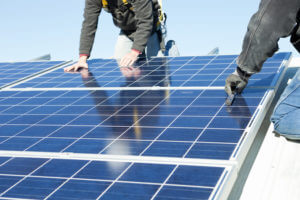 Many industries today, including retail, hospitality, food service, heath care, education and the public sector, are aiming to decrease their carbon footprints and save on energy costs with solar power. But maximizing power generation and minimizing system costs are dependent on several different parameters, including PV design and layout.
Many industries today, including retail, hospitality, food service, heath care, education and the public sector, are aiming to decrease their carbon footprints and save on energy costs with solar power. But maximizing power generation and minimizing system costs are dependent on several different parameters, including PV design and layout.
Designing a highly efficient solar PV system is more of an art than a science. Simple changes can have a sizable effect on optimizing solar energy production, improving return on investment, and offering businesses more insight into their system’s performance.
Optimizing Commercial PV Design and Layout
For any property manager who has already investigated the addition of PV to their commercial building, they know that optimizing commercial PV design and layout is a critical factor to consider. For example, panels can be installed at different tilt angles and varying inter-row spacing in order to achieve its optimal PV design and more power generation.
Every commercial solar installation has its own unique challenges and hence requires careful and meticulous planning. There are three consistent optimization drivers to factor in during the design phase.
1. Shade Tolerance
During the site survey, the area will be inspected for the availability of direct sunlight and shade angles to determine whether it’s suitable for a PV system installation.
Every hour in the day is different: The shade angle of the sun varies as the earth revolves around itself every 24 hours and around the sun every 365 days. It can have a disproportionately large impact on the output of a solar array, especially string configurations where the lowest-performing module may drag down the performance of the entire string. Because an obstruction, even something as small as a mast, can potentially hinder the power output of a solar system, it’s wise to perform a thorough shading analysis of the site first.
Without this insight, increased shade coverage or wide variation from the normal angle of the sun can dramatically result in a loss of energy generation.
2. Panel Layout Consideration
Solar tilt and direction will also directly impact sunlight exposure. Typically at a 20-35 degrees tilt, modules must have a tilt at or near the latitude of the array. Using modeling tools to model various sun angles and layouts for the panels, designs will be adjusted and placed in landscape or portrait to result in optimum sunlight gain and energy yield.
Data collected from geo coordinates and the site’s sun angle help designers determine module spacing and tilt. For example, since many rooftops aren’t perfectly south-facing, modules may be aligned to the south to maximize the energy yield.
3. Inverter Design Optimization
New technologies and inverter topologies, such as three-phase string inverters, optimizers and microinverters, have opened up a variety of options beyond the standard central inverters. Now offering additional modularity and easier replacement, systems can be designed closer to obstructions- minimizing the shading loss on a project.
Commercial PV Design and Layout
As the price of solar panel installation continues to drop and code requirements are constantly changing, the methods used for PV design and layout evolve. At KMB, our solar engineering team offers a comprehensive design-driven approach for each of our clients. As a result, businesses can optimize their unique solar designs to improve system performance and energy production, all without increasing costs.
KMB is a full-service engineering solutions provider licensed in 50 states within the US, Europe and Puerto Rico. We engineer all installation types and have the experience and expertise to factor in all the PV design and layout considerations to help you get the most out of your PV system and improve your rate of return.